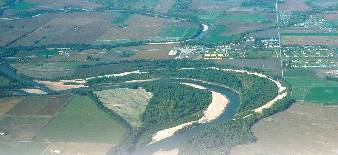mayheader.html

News
Notes
Fieldnotes
Budget cuts for geoscience programs
In early April, President Bush released his budget for the coming fiscal
year, which begins in October. The president’s request to Congress focuses
on campaign pledges to boost defense, education and biomedical research
spending, and to provide a large tax cut. But the administration also aims
to limit growth in federal funding, so these increases are offset by decreases
in most other programs.
The U.S. Geological Survey would receive $813 million, an 8.7-percent
cut from the current fiscal year, with water programs losing 21 percent.
Petroleum and natural gas-related research at the Department of Energy
faces cuts of over 50 percent. The National Science Foundation (NSF) would
receive $4.47 billion, a 1.3-percent increase, but the NSF Geoscience Directorate
would receive 0.6 percent less than it did this year, with no funding for
the Earthscope initiative. Other geoscience-related agencies and programs
face flat funding or cuts. Next month’s Political Scene will provide more
information on the president’s request. For more details, visit www.agiweb.org/gap.
DA
Water woes for farmers
The West Coast has been steeling itself for what the Bureau of Reclamation
in Klamath, Ore., calls a critically dry year. On April 6, the bureau announced
that 90 percent of the farmers in the Klamath Basin of southern Oregon
would not receive any water from the Klamath Water Project. The Project
includes Klamath Lake and the Klamath River, which flows through Oregon
and into California before combining with the Trinity River and pouring
into the Pacific Ocean. The 10 percent of farmers who will receive water
live on the eastern side of the basin where the Clear Creek offshoot of
the Lost River provides supplemental water.
As of early April — the end of the typical rainy season — Bureau of
Reclamation officials in charge of the Klamath Basin Water Project predicted
that this season will be one of the one of the driest since the Project
was established in 1907. Never before have farmers gone without any water,
says Jeffrey McCracken of the Mid-Pacific Bureau of Reclamation. There
are typically 500,000 acre-feet of water to be distributed to regional
farmers. But the combination of drought conditions and environmental regulations
that require lake and river water levels to be maintained for salmon and
suckerfish habitats has resulted in what could be the worst year in the
Project’s 94-year history.
LW
Feeding the future
 As
the world’s population grows larger and wealthier, agricultural lands will
necessarily grow. In the April 13 Science, ecologists explain that
as the world struggles to feed its hungry population it may slowly choke
the planet.
As
the world’s population grows larger and wealthier, agricultural lands will
necessarily grow. In the April 13 Science, ecologists explain that
as the world struggles to feed its hungry population it may slowly choke
the planet.
Agricultural growth taxes the environment — the industry releases large
amounts of nitrogen and phosphates, saps freshwater supplies and converts
natural ecosystems. While none of these problems can be entirely avoided,
we need to take steps to minimize its deleterious effects on the global
environment, explains David Tilman of the University of Minnesota and his
Science co-authors.
Based on changes over the past 40 years in world population, gross
domestic product, nitrogen and phosporous fertilizer usage, pesticide production
and imports, and measurements of global pasture and crop lands, the study
authors forecast how these variables will change in the coming half-century.
They project that nitrogen and phosphates will increase 2.4 to 2.6 fold
— spurring eutrophication of terrestrial, freshwater and near-shore marine
ecosystems. Without better land management techniques, they say, 10 trillion
hectares of natural ecosystem will become agricultural land by the year
2050.
Further research and application of existing knowledge could retard
environmental degredation, but even the best available technologies — present
or future — cannot prevent many of the forecasted problems. Tilman and
colleagues call for improved regional forecasts and predictions based on
mechanistic models.
LW
 As
the world’s population grows larger and wealthier, agricultural lands will
necessarily grow. In the April 13 Science, ecologists explain that
as the world struggles to feed its hungry population it may slowly choke
the planet.
As
the world’s population grows larger and wealthier, agricultural lands will
necessarily grow. In the April 13 Science, ecologists explain that
as the world struggles to feed its hungry population it may slowly choke
the planet.

